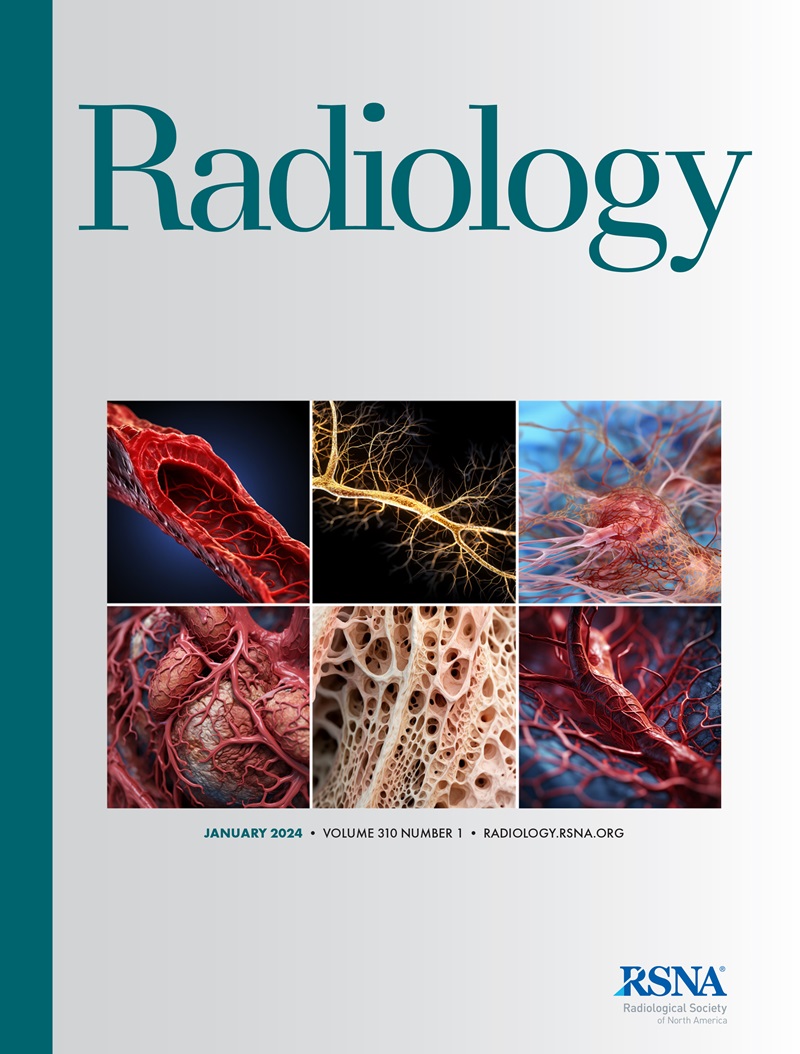Da Hye Lee, Yeon Jin Cho, Jae-Kyung Won, Seul Bi Lee, Young Hun Choi, Kyeong Cheon Jung, Young Joo Park, Yun Jeong Lee, Choong Ho Shin, Young Ah Lee
求助PDF
{"title":"Pediatric Thyroid Nodules: K-TIRADS/ACR TI-RADS Pediatric-Specific Biopsy Cutoff Incorporating Clinical Risk Factors.","authors":"Da Hye Lee, Yeon Jin Cho, Jae-Kyung Won, Seul Bi Lee, Young Hun Choi, Kyeong Cheon Jung, Young Joo Park, Yun Jeong Lee, Choong Ho Shin, Young Ah Lee","doi":"10.1148/radiol.241015","DOIUrl":null,"url":null,"abstract":"<p><p>Background Pediatric thyroid nodules have a higher malignancy rate than adult nodules; yet, a pediatric-specific biopsy cutoff is lacking. Purpose To investigate the usefulness of repeat biopsy and a pediatric-specific biopsy cutoff incorporating risk factors to improve the diagnostic performance of the 2021 Korean Thyroid Imaging Reporting and Data System (K-TIRADS) and American College of Radiology Thyroid Imaging Reporting and Data System (ACR TI-RADS). Materials and Methods US images of biopsy-confirmed pediatric thyroid nodules obtained at Seoul National University Hospital between January 2010 and December 2021 were retrospectively analyzed. The diagnostic performance of the aforementioned systems with the incorporation of risk factors (Hashimoto thyroiditis, previous radiation therapy, family history of thyroid cancer, or hereditary tumor syndrome) was evaluated. The McNemar test and the weighted generalized score statistic were used. Results Two hundred patients (median age, 16 years [IQR, 13-18 years]; 153 female; 17 children [age, <10 years] and 183 adolescents [age, 10-19 years]; 92 with risk factors) with 223 nodules (142 malignant nodules [64% of total nodules; 86% of 166 resected nodules]) were analyzed. Repeat biopsies owing to large size, interval growth, or category 4 and 5 revealed that six of 21 nodules (29%) initially categorized as benign were malignant postoperatively. Compared with the current guidelines, a modified K-TIRADS/ACR TI-RADS pediatric-specific biopsy cutoff (0.5 cm and 1.5 cm for category 4 nodules with and without risk factors, respectively, and 0.5 cm for all category 5 nodules) improved the sensitivity (85% [121 of 142] vs 78% [111 of 142] for K-TIRADS; 84% [119 of 142] vs 60% [85 of 142] for ACR TI-RADS; both <i>P</i> < .005) and missed malignancy rate (33% [21 of 64] vs 39% [31 of 79]; 30% [23 of 76] vs 46% [57 of 122]; both <i>P</i> < .05) for both systems and accuracy for ACR TI-RADS (74% [164 of 223] vs 71% [159 of 223]; 77% [172 of 223] vs 67% [150 of 223]; <i>P</i> = .30 and <i>P</i> = .002, respectively). Conclusion Applying a 0.5-cm biopsy cutoff in pediatric patients improved diagnostic performance for both category 4 nodules with risk factors and category 5 nodules. Repeat biopsy was required for pediatric thyroid nodules with discordant clinical and US findings. © RSNA, 2025 <i>Supplemental material is available for this article</i>.</p>","PeriodicalId":20896,"journal":{"name":"Radiology","volume":"315 3","pages":"e241015"},"PeriodicalIF":12.1000,"publicationDate":"2025-06-01","publicationTypes":"Journal Article","fieldsOfStudy":null,"isOpenAccess":false,"openAccessPdf":"","citationCount":"0","resultStr":null,"platform":"Semanticscholar","paperid":null,"PeriodicalName":"Radiology","FirstCategoryId":"3","ListUrlMain":"https://doi.org/10.1148/radiol.241015","RegionNum":1,"RegionCategory":"医学","ArticlePicture":[],"TitleCN":null,"AbstractTextCN":null,"PMCID":null,"EPubDate":"","PubModel":"","JCR":"Q1","JCRName":"RADIOLOGY, NUCLEAR MEDICINE & MEDICAL IMAGING","Score":null,"Total":0}
引用次数: 0
引用
批量引用
Abstract
Background Pediatric thyroid nodules have a higher malignancy rate than adult nodules; yet, a pediatric-specific biopsy cutoff is lacking. Purpose To investigate the usefulness of repeat biopsy and a pediatric-specific biopsy cutoff incorporating risk factors to improve the diagnostic performance of the 2021 Korean Thyroid Imaging Reporting and Data System (K-TIRADS) and American College of Radiology Thyroid Imaging Reporting and Data System (ACR TI-RADS). Materials and Methods US images of biopsy-confirmed pediatric thyroid nodules obtained at Seoul National University Hospital between January 2010 and December 2021 were retrospectively analyzed. The diagnostic performance of the aforementioned systems with the incorporation of risk factors (Hashimoto thyroiditis, previous radiation therapy, family history of thyroid cancer, or hereditary tumor syndrome) was evaluated. The McNemar test and the weighted generalized score statistic were used. Results Two hundred patients (median age, 16 years [IQR, 13-18 years]; 153 female; 17 children [age, <10 years] and 183 adolescents [age, 10-19 years]; 92 with risk factors) with 223 nodules (142 malignant nodules [64% of total nodules; 86% of 166 resected nodules]) were analyzed. Repeat biopsies owing to large size, interval growth, or category 4 and 5 revealed that six of 21 nodules (29%) initially categorized as benign were malignant postoperatively. Compared with the current guidelines, a modified K-TIRADS/ACR TI-RADS pediatric-specific biopsy cutoff (0.5 cm and 1.5 cm for category 4 nodules with and without risk factors, respectively, and 0.5 cm for all category 5 nodules) improved the sensitivity (85% [121 of 142] vs 78% [111 of 142] for K-TIRADS; 84% [119 of 142] vs 60% [85 of 142] for ACR TI-RADS; both P < .005) and missed malignancy rate (33% [21 of 64] vs 39% [31 of 79]; 30% [23 of 76] vs 46% [57 of 122]; both P < .05) for both systems and accuracy for ACR TI-RADS (74% [164 of 223] vs 71% [159 of 223]; 77% [172 of 223] vs 67% [150 of 223]; P = .30 and P = .002, respectively). Conclusion Applying a 0.5-cm biopsy cutoff in pediatric patients improved diagnostic performance for both category 4 nodules with risk factors and category 5 nodules. Repeat biopsy was required for pediatric thyroid nodules with discordant clinical and US findings. © RSNA, 2025 Supplemental material is available for this article .
儿童甲状腺结节:结合临床危险因素的K-TIRADS/ACR - TI-RADS儿科特异性活检切断。
背景:儿童甲状腺结节的恶性率高于成人结节;然而,缺乏儿科特异性活检的界限。目的探讨重复活检和结合危险因素的儿科特异性活检切断的有效性,以提高2021年韩国甲状腺成像报告和数据系统(K-TIRADS)和美国放射学会甲状腺成像报告和数据系统(ACR TI-RADS)的诊断性能。材料与方法回顾性分析2010年1月至2021年12月在首尔国立大学医院获得的活检证实的儿童甲状腺结节的美国影像。结合危险因素(桥本甲状腺炎、既往放射治疗、甲状腺癌家族史或遗传性肿瘤综合征)对上述系统的诊断性能进行评估。采用McNemar检验和加权广义评分统计。结果200例患者(中位年龄16岁[IQR, 13-18岁];153名女性;17例患儿[年龄,P < 0.005],肿瘤漏诊率(64例中21例为33%,79例中31例为39%);30%(76人中的23人)vs 46%(122人中的57人);两种系统和ACR TI-RADS的准确性均P < 0.05)(74%[223人中的164人]对71%[223人中的159人];77%(223人中有172人)vs 67%(223人中有150人);P = 0.30, P = 0.002)。结论在儿童患者中应用0.5 cm活检分界线可提高对具有危险因素的4类结节和5类结节的诊断效能。临床和超声检查结果不一致的儿童甲状腺结节需要重复活检。©RSNA, 2025本文可获得补充材料。
本文章由计算机程序翻译,如有差异,请以英文原文为准。

 求助内容:
求助内容: 应助结果提醒方式:
应助结果提醒方式:


